The history of the Sisters of Divine Providence reveals a fascinating series of adventures linked by a zeal to minister and further the mission of Jesus.
John Martin Moye, 1762
It all began in Alsace, France as a project of a zealous young parish priest, John Martin Moye, who was concerned for the education of children in the villages surrounding Metz. He recruited young women who were disposed and persevering to prepare for ministry in the villages. In 1762, Moye began sending the young women, alone or by twos, into the villages to school the children in their faith and basic skills. Marguerite Lecomte was one of the first Sisters of Providence sent out by Father Moye.
Sisters of Providence
They went armed with the four fundamental virtues with which he had imbued them: Abandonment to Divine Providence, Simplicity, Poverty, and Charity. At first the villagers were wary of them, but soon accepted them and called them Sisters of Providence. Thus, the project developed into the Congregation of Divine Providence (CDP).

 Mother St. Andrew Feltin sails to Texas
Mother St. Andrew Feltin sails to Texas
It was in 1866, that Mother St. Andrew Feltin and Sister Alphonse Boegler, left St. Jean de Bassel in answer to the call of Bishop Dubuis of Texas to establish schools in Texas. They landed in Galveston on October 25. After some time with the Ursuline Sisters, resting and getting oriented to the language and Texas ways, they traveled to Austin, arriving on December 2.
Castroville becomes our home
In early April of 1867 they opened their first parochial school in Texas, St. Mary’s School. In 1868 the Bishop asked the Sisters to establish their Motherhouse in Castroville, Texas, an Alsatian immigrant town west of San Antonio.
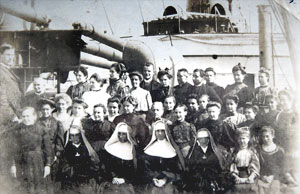
The numbers of schools and Sisters grow
Immediately, work started in founding schools in the Castroville area as young women joined the fledgling Congregation. Requests came from pastors all over Texas, and later from Louisiana and Oklahoma, for Sisters to open schools in their parishes. There were also settlements without churches, far from towns, in need of literacy and God’s Word.
Trips to Europe to recruit young women
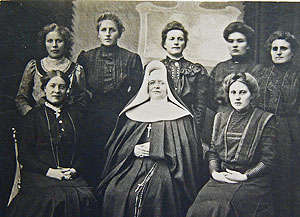
The number of places wanting Sisters soon exceeded the number of Sisters available. This prompted Mother St. Andrew to return to Europe for more workers for God’s American vineyard. She went twice visiting Poland and Ireland, as well as St. Jean de Bassel. Trans-Atlantic travel had its dangers, but Sisters and aspiring young women were necessary to meet the needs of the Lord’s work. So, it happened on the second crossing from Europe that courage and trust in Providence were brutally tested by a fierce storm. Mother’s group bounced and rolled as wind and rain pounded the ship. When the storm subsided, there was grateful silence as fingers continued on one more rosary in thanksgiving.
We left home on the twenty-third, St. Jean de Bassel on the twenty-fourth, and Havre, where we met some Postulants from Ireland, on the twenty-sixth of August. God’s protection was with us and we reached Castroville safely after a month’s travel. We were twenty-eight in all; among the number were Sisters and four Novices from the Convent in Europe. Having companions from the Emerald Isle on board the ship, we made use of the opportunity to learn some English. We were taught the “Our Father, Hail Mary, Creed, and the Angelus”; but alas! for my German ears and tongue!!! It was quite a long while before I realized the difference between the two phrases “born of the Virgin Mary” and “Baum auf dem Welschen Meers.” I am sure my companions did not fare any better.
–Mother Antoinette Loth- leaving home August 23, 1881
Success and grief
Mother St. Andrew was committed to opening schools where they were needed, and so faith and literacy were spread. This was her purpose and she was driven to succeed. And succeed she did. During her 20 years in Castroville 24 schools were established, a very satisfying beginning. But success often comes with suffering.
Among the problems disheartening and threatening to the infant Congregation were the intrusive dominance and control of the Congregation by bishops and clerics; two small groups of Sisters defected.
A profound challenge
But the most disruptive was the expulsion from the Congregation of the first Superior General of the Texas Foundation, Mother St. Andrew Feltin, who was victimized by injustices and collusion among certain clerics.
Bishop Neraz demanded that the Sisters of Divine Providence elect someone else in place of Mother St. Andrew Feltin. The Sisters held several votes and each time Mother St. Andrew was elected. After the fifth round of voting, Mother St. Andrew asked the Sisters to choose Sister Florence Walters. At the time, Sister Florence was on a train on her way to meet the Sisters in Castroville.
Mother St. Andrew’s Successor
As Sister Florence got off the train from Galveston, she was welcomed and informed of her election as Superior General. At that moment, Sister became Mother Florence Walters to the congregation.
In 1882 I was sent to Frelsburg. Our house was poor and exercise was not wanting. We had to take a regular good long walk each day to go after water. We also learned how to split the wood for fire to prepare our meals. A man would cut down the tree but left it to us to make it fit for the kitchen. Many were our hardships.
Sister Catherine Friesenhahn-1882
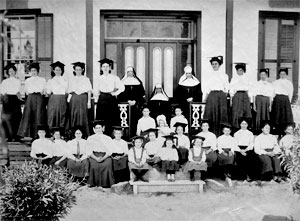
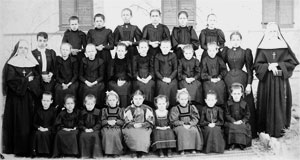
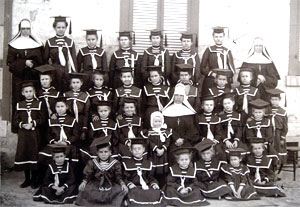
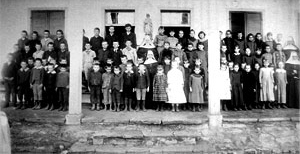
Mother Florence leads the congregation
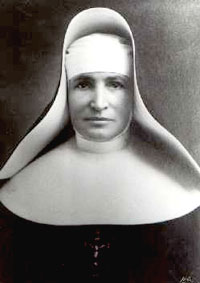
Under Mother Florence Walter, Second Superior General, the number of schools and hospitals grew to over 150 by 1945.
These courageous Sisters of diverse backgrounds shaped the Texas CDP spirit marked by trust in a provident God. They embarked on the mission chartered by Mother St. Andrew Feltin to open schools where children were lacking access to education.
Opening schools for Native American and African American children
The Sisters pioneered among the Native Americans and African American children, first starting separate schools, then -against opposition- integrating them. The Congregation became known as having schools with strong programs and excellent teachers.
Notable during Mother Florence’s administration (1886-1925) was the opening of the first school in Louisiana, St. Francis Xavier Academy in Alexandria, and in 1894 the Sisters began teaching black children in St. James School (Alexandria). Sacred Heart Academy in Vinita (Indian Territory) was opened followed by numerous other schools in Louisiana and Indian Territory.
San Antonio becomes home
In 1895 Mother Florence Walter moved the Motherhouse from Castroville to San Antonio. An Academy for girls was begun and affiliated with the University of Texas at Austin.
Education for the Sisters
A large part of the success of the Sisters’ ministries was the education which they received. This was primarily a result of establishing Our Lady of the Lake College which grew out of the summer Normal School associated with the Catholic University of America.
The beginnings of Our Lady of the Lake College
In 1911 a two-year college opened and was affiliated with the Catholic University of America. A four year curriculum was offered in 1919 and Our Lady of the Lake College received membership in the Texas Association of Colleges and Universities. Four years later it was accredited by the Southern Association of Colleges and Universities.
Today, this institution flourishes as Our Lady of the Lake University.
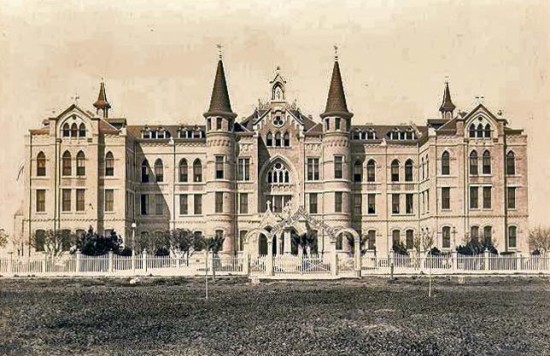
Landing in Galveston, we knew nothing of the heat here in August and, wanting to look alike, we put on our black serge dresses with lining. We surely felt warm enough in the train to San Antonio. On reaching the Convent, the first thing I noticed was the statue of Our Lady in front of the Academy building. I saluted her with a Hail Mary for perseverance. I felt at home, being glad to stop at some destination because I was sick and tired of traveling.
The hardest thing for me was to sit quietly, especially during Spiritual Reading which I did not understand. All the others listened with amazement. At other times they would smile and laugh out loud at the stories related to them by our dear mistress, the present Rev. Mother.
Sister Conrad Balewski- 1906- trip to America
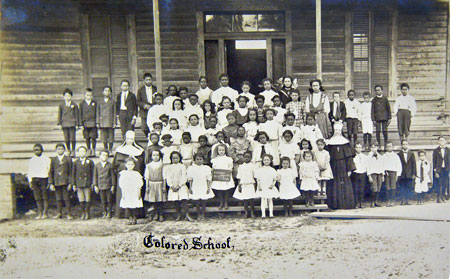
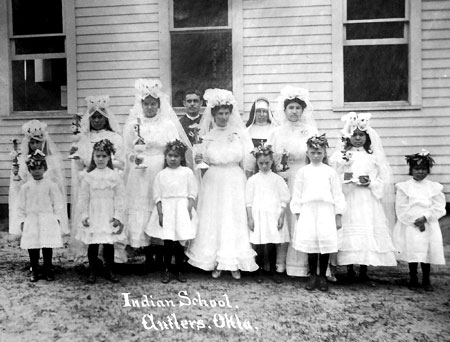
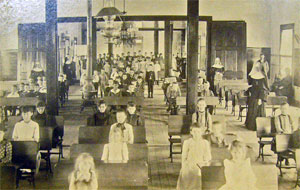
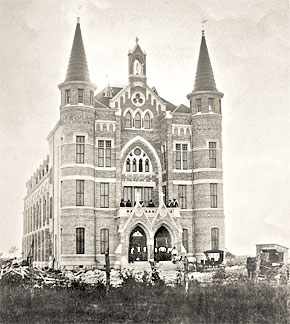
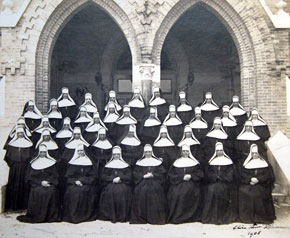
In 1920 the walls of Wallis Convent enclosed me in their frame. On the feast of the Immaculate Conception, Sister Bernard came and said, “you have to leave today for Isle Breville; “Look, here is the letter, read it, and get ready. “ When I came near Isle Breville and saw the poor little houses of the people almost falling on their heads, I was moved to tears. I said to myself: “This is indeed where I like to be.” The poor, forsaken Colored people peeped through the holes in the walls (which were used as windows) to see the new Sister.
Sister Mary Bona Reiff-1920
Congregation works as a whole to expand OLLC
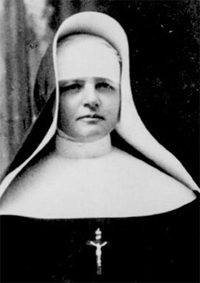
Mother Florence’s long term as Superior General ended with the election of Sister Philothea. She had served as secretary to Mother Florence and served on her Council for a time where she was a proficient influence. She was organized and strategic in her service to the Congregation. Her greatest asset was to look ahead and see the needs of education for the Sisters. She saw requirements were changing with time and certification would be needed if the schools were to continue.
A great expansion of curriculum would be required as the State’s certification advanced. As the requirements grew, so must the College. So it was that more buildings were vital to keeping up with the education of teachers. Moye Hall had been erected as the College Building in 1919. Here, not only Sisters had been prepared for the classroom, but other women as well. Accrediting organizations required buildings with special fixtures and accommodations not possible in one building. Mother Philothea began planning and prioritizing until by the end of her administration there were seven college buildings, accreditation by the esteemed Association of American Universities, and a number of Sisters had received graduate degrees.
Sacred Heart Chapel
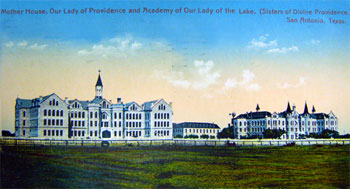
Early in her administration Mother Florence had expressed the desire of having a Gothic chapel with tall steeples similar to those in France. She had forgone building it until the College had what it needed. In planning the lay out of the College buildings, Sister Philothea left the land between the College and the Convent buildings open for the Chapel. She also started a Chapel Fund which Mother Florence managed. The primary source of funds was the sale of needle work done by the Sisters and their pupils, and all gifts of candy (to be sold) and money made to the Sisters were sent to the Convent for the Chapel Fund. Each Sister (about 485) also received a dime book which they somehow managed to fill with dimes and turn it in to the fund. A second fund begun in the early twenties was the Altar Fund under the supervision of Mother Florence.
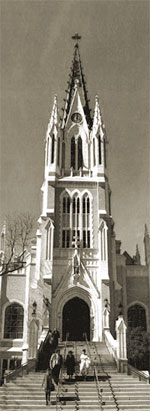
It was 1921 when sufficient funds were accumulated to begin construction on the chapel. The Sisters continued their fund raising and prayers during construction and Divine Providence brought additional donors, such that the cornerstone and steeple cross were blessed put in place in June 1922. The interior was readied and stained glass windows were installed in January 1924. When the Chapel was completely finished and free of debt, it was consecrated on July 26, 1928. Mother Florence was filled with pleasure as the Sisters celebrated this milestone as a gift for her golden jubilee.
View the interior of the chapel here.
It was on August 15, 1919, that twenty three Novices pronounced their first vows and went forth with great zeal and fervor. All of us felt like St. Peter, sword in hand, ready to cut off (not the ear of Malchus) but the heads of ignorance and vice. But alas! how different at least in the writer’s case; the first efforts were spent in keeping 42 second and third grade pupils in their respective places who were trying to get as many paper air-ships as possible through the open window. These were the trials during school hours and after school…
Sister Consortia Klein
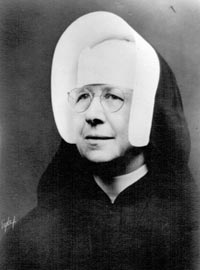
The first US-born Superior General is elected in 1943
Born in Mississippi in 1882 into a family of Protestant immigrants from Europe, Sister Mary Angelique Ayres became the fourth Superior General of the Congregation. She converted to Catholicism in 1897 while attending an academy taught by Sisters of the Holy Cross in Austin, Texas; and four years later she entered the Congregation of Divine Providence. She would go on to lead 700 Sisters who served over 23,000 people, mostly as teachers, domestic workers, catechists, and health care workers.
The establishment of Our Lady of the Lake College with its increasingly extensive teacher-training programs gave further impetus to the expansion of the Congregation’s educational ministry. CDP teachers opened more missions in Louisiana, Oklahoma, Indian territories, Texas, and Arkansas. These ventures helped the Congregation to meet the needs of minority cultural groups.
CDPs in Mexico
In the early 1950s Father Pedro Moctezuma, Vicar General of San Potosi, Mexico appealed to Mother Angelique, fourth Superior General, to provide instruction and training for young Mexican women to do catechetical work in Mexico. Sister Rachel Moreno, a one-time Mexican citizen had previously consulted with Mother Angelique about opening a house in Mexico. In 1953, after visiting Mexico, Mother Angelique agreed to provide the catechetical training and five young women came to San Antonio to be trained by Sister Rachel.
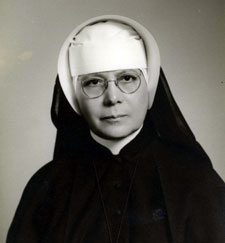
Sister Rachel Moreno establishes a new CDP house in Mexico
Originally the women were not intended to be vowed religious, but in 1957 they expressed a desire to become Sisters of Divine Providence. Sister Rachel went to Mexico to establish the new CDP house with the five new members-to-be. As their numbers increased, they responded to ministry in Queretaro, Mexico City, Saltillo, Tehuantepec, and San Cristobal.
Expanded Ministries
Midway through the 20th century, the confluence of cultural, religious, national, and international shifts and upheavals led to profound changes in the U.S., in the Church, and in the Congregation. Along with changes in the Sisters’ daily practices and dress came a broader understanding of their call.
The Congregation widened its ministerial path to include diversity and opportunities to network with public and religious organizations in reaching out to disenfranchised groups—migrant workers, sugar cane workers, African “bush” people, mountain folk, bayou folk, abused women, deaf people, homeless people. Sisters trained adults and young people for community leadership, established a social justice office, assisted in housing for the poor, and opened a home for HIV/AIDS-infected children.
In all of these works, the Sisters continue Father Moye’s directive to perform the works of mercy wherever they go.
Health Care and Social Ministries
The Sisters in schools had always stepped in to help heal their sick neighbors and the children in their care. With a growing population in Texas, hospitals were founded in some of the cities. However, there were smaller unserved cities and towns that also needed health care. In God’s Providence, there were Sisters in the Congregation who had strong interest in the health care and social ministries. As opportunity and requests for help reached the administration they responded with hospitals, clinics, and social services, among them:
Hospitals / Clinics
St. Ann’s Hospital
Madonna Hospital
Floresville Memorial Hospital
Stella Maris Clinic
Providence Home and Family Services (for children with AIDS)
Social Ministry
Madonna Neighborhood Center
The Worden School of Social Work
Centro del Barrio
A more detailed history of these ministries can be found in Living in God’s Providence by Sister Mary Christine Morkovsky. The book is available in our Online Store.
Meeting the needs of God’s people
The post Vatican II era ushered in the evolution of many personal, spiritual, internal governmental changes that fostered growth and addressed the signs of the times. While great in number and younger in age, the Sisters were able to discern their ministry choices. They maintained some schools in Texas and Louisiana, and worked in a few hospitals and clinics. But many reached out to new ministries.
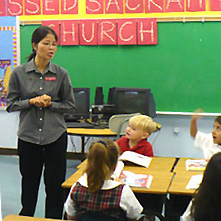
In the 1980s to the present, the Sisters (CDPs) served in many parishes throughout Texas, other states and Mexico as pastoral associates, coordinators, religious education and adult formation directors, retreat coordinators and spiritual directors.
In the education field they served as university professors, librarians, archivists and administrators, high school and elementary school principals, classroom, and music teachers, pre-school teachers, private English tutors and as faculty, accountants and associates in seminaries.
Although no longer staffing hospitals, Sisters continued healthcare ministries as certified nurse midwife, certified nurse practitioner and counselor, executive assistant, wellness mentor, and hospice and hospital chaplains.
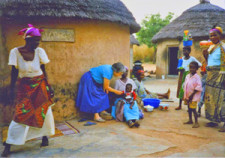
The call to seek economic and social justice in society and in the work place continued to be addressed through collaboration with non-profit organizations.
In the late 1990s three Sisters were commissioned to Africa with the intent of having a continuous presence there. However, after three years, the mission was absorbed into the Ghana Education Service, thus ending the CDP International ministry in Africa. The Sisters of Divine Providence continue to support international missions through their hospitality, financial support and daily prayers.
New establishments to address the signs of the times
Mobile Ministry
From a vision in 2005 of continuing the Ministry of the Sisters of Divine Providence by going to places where they once had a presence or to new places that need to hear God’s Word arose the idea of a Mobile Ministry. This contemporary “vehicle” allowed the Sisters to travel to parishes, schools, etc. to offer retreats and workshops. This ministry served the people of God through 2017.
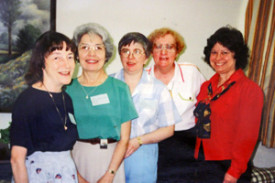
Associates Program and Formation
From 1967 to 1981, following the Vatican II Council, the CDPs continued to involve alumni, friends and laity collaborating in many different ways to further the mission. The CDP Chapter of 1981 established the Associates with an initial study and committee. By 1985, the first Associates were invited to be formed and to make a commitment.
Sister Mary Clare Metz 1985- 1987 (first director)
Sister Elise Bengfort 1987-1992
Sister Emily Rabalais 1992 – 1999
Florence Carvajal, ACDP 2000 – 2005
Sister Lucille Ann Fritsch 2006 – 2015
Ana María De La Portilla, ACDP 2015 – 2024
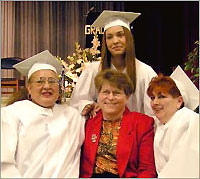
Sophia Women’s Learning Center
Sophia Women’s Learning Center (SWLC) began early in 2003 at Providence High School as the brainstorm of faculty member, Paul Hass, who wanted to reach out to young women who had interrupted their high school education.
Later the SWLC moved to the Our Lady of the Lady Convent. With the help of an implementation grant, Sister Ann Umscheid, CDP served as the first Director and Ida Ayala, ACDP followed her as Director. During its ten years, numerous women enrolled in the program and forty women graduated from the program. SWLC held it last graduation on December 21, 2013.
Responding to the needs of her time, Sister Mary Benitia trained missionary catechists
In the late 1920’s in Houston, Texas, where there were thousands of impoverished Mexican Americans, Sister Benitia Vermeersch, CDP organized a group of young women to do catechetical work. This pious society was the nucleus of the San Antonio-based Missionary Catechists of Divine Providence (MCDP), granted papal approval in 1946 as a branch of the Congregation. They are engaged in Ministry of the Word, in social ministry, and in diocesan and parish leadership positions in the Southwest. On December 12, 1989, the Missionary Catechists of Divine Providence became an independent religious Congregation with the approval of their Constitution.
Read more: Missionary Catechists of Divine Providence (pdf)
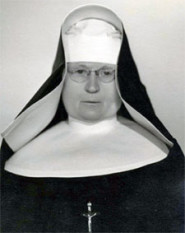


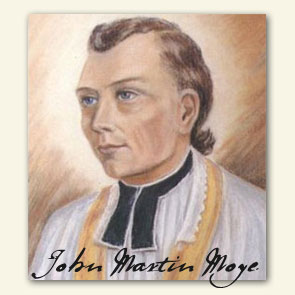

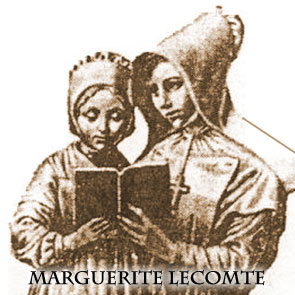
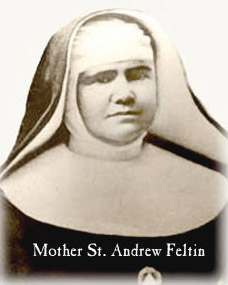 Mother St. Andrew Feltin sails to Texas
Mother St. Andrew Feltin sails to Texas